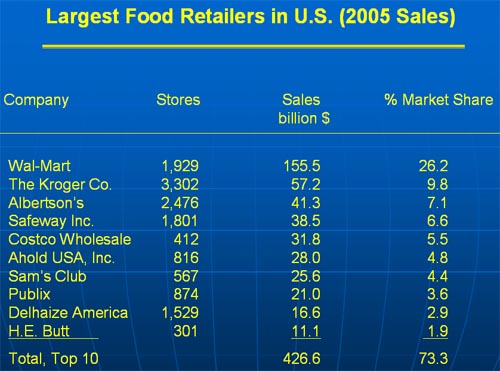Terry Etherton
The U.S. Food System is a remarkable infrastructure that many in the U.S. take for granted. As shown in Figure 1, the Food System is complex, ranging from agricultural production to the many steps that take place to process, package and move food to the shelf in the grocery store and food service outlets. The left column in Figure 1 presents the various steps in the Food System ending in consumption. The arrows depict flow from one channel to another. Local assemblers are companies that collect agricultural products from producers and the redistribute them to other firms in the marketing channel. Grain elevators would be an example of a local assembler; they buy grain from local producers and usually sell this to processors. Terminal processors are companies that buy products from producers and/or from local assemblers. Typically terminal processors are larger than local assemblers and usually are situated at terminal markets that are involved in exporting agricultural commodities.
The processing and marketing components of the Food System are steps that many consumers have a better understanding of since they are purchasing many processed food products. The marketing piece is ever-present in the various media outlets, and is used effectively by subsequent components in the Food System to manage and grow market share, i.e., sell more product. It is remarkable that this level of food production and processing has evolved and done so in a way where people living in developed countries have the safest food supply in recorded history. This is a luxury that is under-appreciated by many.
The Food System in the U.S. is a major sector of the U.S. economy. One measure of this is the sales at grocery stores and convenience stores. In 2005 this was approximately $582 billion! The food and fiber system (FFS) added $1.24 trillion to the Nation’s gross domestic product (GDP), a measure of the Nation’s wealth, and provided jobs for more than 23 million workers. The FFS share of total GDP represents about 12 to 15% of the total U.S. GDP.
The evolution of the Food System has been associated with many changes at the grocery level of the Food System. In 2005, the ten largest U.S. food retailers (see Table 1) had sales of $427 million, which accounted for than 73% of total market share. Wal-Mart now accounts for approximately 26% of all food sold in the grocery category in the U.S. The top three companies sell about 44% of all food sold in grocery stores and supermarkets in the U.S. The trend towards fewer and larger retail enterprises corresponds to the trend seen in farm number and size.
What does the future look like for the U.S. Food System? The continued development of new technologies and science will likely allow food production to keep pace with society needs. As robust as the food system is in the context of producing food, it is remarkable fragile (see Blog: Impact of Bioterrorism on Animal Agriculture in the U.S.). In the absence of a large-scale attack on the Food System, people living in the U.S. will continue to enjoy the impressive number and selection of food that available at grocery stores and food service outlets.
Figure 1.

Table 1.
